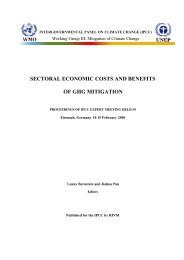Pacific Islands Environment Outlook - UNEP
Pacific Islands Environment Outlook - UNEP
Pacific Islands Environment Outlook - UNEP
Create successful ePaper yourself
Turn your PDF publications into a flip-book with our unique Google optimized e-Paper software.
14<br />
STATE OF THE ENVIRONMENT<br />
of marine resources were perhaps partly responsible for<br />
the development of traditional fisheries protection<br />
strategies such as closed seasons and areas, gear<br />
restrictions, and restrictions on species that could be<br />
caught and who could catch them (Johannes 1982).<br />
However, in most cases the pressure on marine and<br />
coastal resources is not considered to have been a<br />
serious issue until relatively recently (Baines 1984).<br />
Developments over the past 10 years<br />
As coastal areas are home to most of the region’s<br />
population, and the entire populations of the smaller<br />
low-lying islands, changes in population density,<br />
combined with new technology and changing<br />
development priorities, have had a particular impact on<br />
coastal environments. Uses of the coastal zone, or<br />
activities that take place within it, may be aquatic or<br />
terrestrial in PICs and typically include the following:<br />
●<br />
●<br />
●<br />
●<br />
●<br />
●<br />
●<br />
●<br />
●<br />
●<br />
●<br />
●<br />
●<br />
fishing;<br />
coastal shipping;<br />
port and harbour development;<br />
water-based recreation, such as diving and other<br />
tourism-related activities;<br />
coastal construction – building of houses, hotels,<br />
commercial and industrial premises;<br />
infrastructure development – building of roads,<br />
installation of power and water supplies;<br />
sewage treatment and disposal;<br />
rubbish dumping, discharge of factory effluent and<br />
other forms of waste disposal;<br />
coastal protection – construction of sea walls or<br />
other forms of shoreline stabilization;<br />
agriculture;<br />
logging;<br />
mining of various types, including petrochemical<br />
extraction;<br />
modification of watercourses (dams, etc.).<br />
Imminent threats to marine and coastal resources<br />
resulting from these developments over the past ten<br />
years have been outlined in the Strategic Action<br />
Programme for International Waters in the <strong>Pacific</strong><br />
<strong>Islands</strong> Region (SPREP 1999b). These include:<br />
●<br />
●<br />
●<br />
nutrients derived from sewage, soil erosion and<br />
agricultural fertilizers; eutrophication;<br />
solid waste disposal, particularly in urban areas;<br />
sedimentation resulting from land clearance and<br />
increased erosion;<br />
●<br />
●<br />
physical alterations caused by destruction of fringing<br />
reefs, beaches, wetlands and mangroves for coastal<br />
development and by sand extraction;<br />
overexploitation of coastal food fisheries, particularly<br />
through destructive fishing methods.<br />
Specifically, increasing urbanization, dredging and<br />
landfill have caused erosion and sedimentation of reefs,<br />
sewage discharge has reduced water quality, reef fish<br />
are starting to be overexploited due to fishing<br />
pressure, rubbish is being dumped along the foreshore<br />
and nesting sea turtles have been eliminated from the<br />
area (Bryant et al. 1998; SPREP 1996). Land<br />
reclamation and natural erosion as a result of wave<br />
action is also regarded as an imminent threat to the<br />
marine environment by Cook <strong>Islands</strong>, Samoa and<br />
America Samoa (SPREP 1998a). Marine invasive<br />
species have been identified as an issue in some ports<br />
and coastal habitats. There is also a need to address<br />
ship-sourced marine pollution in the region (SPREP<br />
1998a). Whilst not a serious problem in PICs, it is a<br />
concern and the threat is likely to increase as trade<br />
and economies develop further. The role of transit<br />
shipping and foreign fishing fleets in this issue should<br />
be highlighted. It should be noted that imminent<br />
threats to international (deep) waters and offshore<br />
areas are encouraging the <strong>Pacific</strong> island countries to<br />
control and fully utilize their EEZs.<br />
The coastal zone is extremely vulnerable and the<br />
irreversible nature of many impacts (such as the<br />
destruction of seagrasses, mangroves and reef habitats)<br />
make it an ideal indicator of the state of the<br />
environment in the <strong>Pacific</strong>. The information gaps are,<br />
however, once again serious, as illustrated by the<br />
international waters document (SPREP 1997a), which<br />
lists across three pages topics for which data are nonexistent<br />
or seriously deficient.<br />
Whilst land-based and coastal zone environmental<br />
issues are a recognized priority in the region, it is also<br />
important to appreciate the significance of the oceanic<br />
environment. By far the greatest area in the western and<br />
central <strong>Pacific</strong> is deep ocean. This supports, amongst<br />
other things, the world’s largest tuna fishery, which, with<br />
the exception of one species (Bigeye), is in relatively<br />
good health. Clearly fisheries resources represent a<br />
major focus for long-term economic development in the<br />
region. This has the capacity to finance consolidated<br />
revenue, with flow-on benefits for environmental areas<br />
not currently receiving attention. The challenge facing<br />
the region in terms of the oceanic environment is to

















